A relatively simple but counterintuitive approach aims to fight climate change — by actually increasing CO2 emissions.

Fighting climate warming with greenhouse emissions might sound like it won’t work, because it wouldn’t. The team that authored this study, however, doesn’t just aim to increase CO2 levels in the atmosphere. Rather, it proposes that we degrade methane, a much more potent greenhouse gas, into CO2 — the swap, they write, would be a net benefit for world climate.
The study proposes zeolite, a crystalline material that consists primarily of aluminum, silicon, and oxygen, as a key material to help us scrub methane emissions.
The lesser of two evils
“If perfected, this technology could return the atmosphere to pre-industrial concentrations of methane and other gases,” said lead author Rob Jackson, the Michelle and Kevin Douglas Provostial Professor in Earth System Science in Stanford’s School of Earth, Energy & Environmental Sciences.
Much more relevant to the current situation, the team notes, is that this process is also profitable. Boiled down, the idea is to take methane from sources where it’s difficult or expensive to eliminate — from cattle farms or rice paddies, for example — and degrade it into CO2.
Methane concentrations in the atmosphere are almost two-and-a-half times higher today than before the Industrial Revolution, the team explains. There’s a lot less methane than CO2 in the air, granted, but methane is 84 times more potent than CO2 as a climate-warming gas over the first 20 years after its release. Finally, some 60% of atmospheric methane today is directly generated by human activity.
Most climate strategies today focus on CO2, which is understandable. It’s the largest (by quantity) greenhouse gas we emit, and it’s easy to relate to — we breathe out CO2, cars belch out CO2, factories do too, and plants like to munch on it. But scrubbing other greenhouse gases, particularly methane due to its enormous greenhouse effect, could be useful as a complementary approach, the team explains. Furthermore, there’s just so much CO2 already floating around — and we keep pumping it out with such gusto — that CO2-removal scenarios often call for billions of tons to be removed, over decades, which would still not get us to pre-industrial levels
“An alternative is to offset these emissions via methane removal, so there is no net effect on warming the atmosphere,” said study coauthor Chris Field, the Perry L. McCarty Director of the Stanford Woods Institute for the Environment.
Methane levels could be brought back down to pre-industrial levels by removing about 3.2 billion tons of the gas from the atmosphere, the team notes. Converting all of it into CO2 would be equivalent to a few months of global industrial emissions, which is relatively little, but would have an outsized effect: it would eliminate approximately one-sixth of all causes of global warming to date.
So why then didn’t anybody think of this before? Well, the thing is that methane is hard to scrub from the air because its overall concentrations are so low. However zeolite, the team explains, is really really good at capturing the gas due to its “porous molecular structure, relatively large surface area and ability to host copper and iron,” explains coauthor Ed Solomon, the Monroe E. Spaght Professor of Chemistry in the School of Humanities and Sciences. The whole process could be as simple as using powerful fans to push air through reactors full of zeolite and catalysts. This material can then be heat-treated to form and release carbon dioxide gas.
Now let’s talk money. If market prices for carbon offsets rise to $500 or more per ton this century as predicted by most relevant assessment models, the team writes, each ton of methane removed from the atmosphere could be worth more than $12,000. A zeolite reactor the size of a football field could thus produce millions of dollars a year in income while removing harmful methane from the air. This is very fortunate as, in my experience, nothing motivates people to care about the environment quite like making money from saving it.
In principle, the researchers add, the approach of converting a more harmful greenhouse gas to one that’s less potent could also apply to other greenhouse gases.
The paper “Methane removal and atmospheric restoration” has been published in the journal Nature Sustainability.


